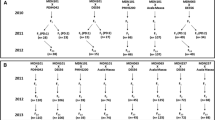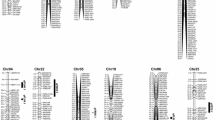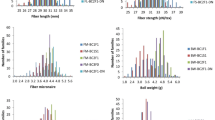Abstract
DNA markers linked with major QTL contributing to traits of importance will be a useful tool for cotton (Gossypium spp.) genetics and breeding. We crossed four photoperiod-sensitive accessions of cotton, G. hirsutum L., with a cultivar, selected day-neutral plants and backcrossed four times to each of the four photoperiod-sensitive accessions, selecting day-neutral plants at each generation. The day-neutral plants from the first cross and the four backcross generations were advanced to the F6. These 20 day-neutral lines and four cultivars were grown in two environments at Mississippi State, MS and scored for seven agronomic and fiber quality traits. They were also scored for AFLP markers using a bulk sample of leaves from each of 24 lines. More than 50 AFLP markers were associated with the seven traits with fewer markers associated with fiber than agronomic traits. However, one to four markers were associated with 22–93% of the phenotypic variability of each of the seven traits. The results suggest that selected markers could be used in marker assisted selection (MAS) in crosses designed to use alleles from exotic accessions or cultivars to develop elite breeding lines for cotton improvement.
Similar content being viewed by others
References
Abdalla AM, Reddy OUK, El-Zik KM, Pepper AE (2001) Genetic diversity and relationships of diploid and tetraploid cotton rervealed using AFLP. Theor Appl Genet 103:547–554
Bowman DT, Gutierrez OA (2003) Sources of fiber strength in the U.S. upland cotton crop from 1980 to 2000. J Cotton Sci 7:164–169
Bowman DT, May OL, Calhoun DS (1996) Genetic base of upland cotton cultivars released between 1970 and 1990. Crop Sci 36:577–581
Bowman DT, May OL, Creech JB (2003) Genetic uniformity of the U.S. upland cotton crop since the introduction of transgenic cotton. Crop Sci 43:515–518
Brubaker CL, Wendel JF (2001) RFLP diversity in cotton. In: Saha S, Jenkins JN (eds) Genetic improvement of cotton, emerging technologies. Science Pulisher Inc., Enfield, CO, pp 3–31
Cantrell RG, Davis DD (1993) Characterization of hirsutum × barbadense breeding lines using molecular markers. In: Herber D (ed) Proc Beltwide Cotton Prod Res Conf, Natl. Cotton Council Am., Memphis, TN, pp 1551–1553
Guo W, Zhang T, Shen X, Yu J, Kohel RJ (2003) Development of SCAR marker linked to a major QTL for high fiber streng and its usage in molecular-marker assisted selection in upland cotton. Crop Sci 43:2252–2256
Gutierrez OA, Basu S, Saha S, Jenkins JN, Shoemaker DB, Cheatham CL, McCarty JC (2002) Genetic distance among selected cotton genotypes and its relationship with F2 performance. Crop Sci 42:1841–1847
He D, Lin Z, Zhang X, Nie Y, Guo X, Feng C, Stewart JM (2005) Mapping QTLs of traits contributing to yield and analysis of genetic effects in tetraploid cotton. Euphytica 144:141–149
Jiang C, Wright RJ, El-Zik KM, Paterson AH (1998) Polyploid formation created unique avenues for response to selection in Gossypium (cotton). Proc Natl Acad Sci USA 95:4419–4424
Jiang C, Wright RJ, Woo SS, DelMonte TA, Paterson AH (2000) QTL analysis of leaf morphology in tetraploid Gossypium (cotton). Theor Appl Genet 100:409–418
Jin J (2003) Genetic analysis of quantitative traits and recurrent selection of yield traits in Upland cotton. Ph. D. Diss. Nanjing Agric. Univ., Nanjing, China
Kohel RJ, Yu J, Park YH, Lazo GR (2001) Molecular mapping and characterization of traits controlling fiber quality in cotton. Euphytica 121:163–172
Lacape JM, Nguyen TB (2005) Mapping quantitative trait loci associated with leaf and stem pubescence in cotton. J Heredity 96(4):441–444
Lacape JM, Nguyen TB, Thibivilliers S, Bojinov B, Courtois B, Cantrell RG, Burr B, Hau B (2003) A combined RFLP-SSR-AFLP map of tetraploid cotton based on a Gossypium hirsutum × Gossypium barbadense backcross population. Genome 46:612–626
Lacape JM, Nguyen TB, Courtois B, Belot JL, Giband M, Gourlot JP, Gawryziak G, Roques S, Hau B (2005) QTL analysis of cotton fiber quality using multiple Gossypium hirsutum × Gossypium barbadense backcross generations. Crop Sci 45:123–140
Lazo GR, Park YH, Kohel RJ (1995) Mapping fiber quality in interspecific Gossypium hirsutum and Gossypium barbadense. In Herber D (ed) Proc. Beltwide Cotton Prod. Res. Conf., San Antonio, TX, 4–7 Jan. 1995. Natl. Cotton Council of Amer., Memphis, TN
Lewis H (2001) A review of yield and fiber quality trends and components in American upland cotton. In Proc. Beltwide Cotton Conf., Anaheim, CA. 9–13, 2001. Natl. Cotton Concil Am., Memphis, TN, pp 1447–1453
Lin Z, He D, Zhang X, Nie Y, Guo X, Feng C, Stewart JM (2005) Linkage map construction and mapping QTL for cotton fibre quality using SRAP, SSR and RAPD. Plant Breed 124:180–187
Liu S, Cantrell G, McCarty JC Jr, McD Stewart J (2000a) Simple sequence repeat-based assessment of genetic diversity in cotton race stock accessions. Crop Sci 40:1459–1469
Liu S, Saha S, Stelly D, Burr B, Cantrell RG (2000b) Chromosomal assignment of microsatellite loci in cotton. J Hered 91:326–332
Lu H, Myers GO (2002) Genetic relationship and discrimination of ten influential upland cotton varieties using RAPD markers. Theor Appl Genet 105:325–331
McCarty JC Jr, Jenkins JN (1993) Registration of 79 day-neutral primitive cotton germplasm lines. Crop Sci 33:351
McCarty JC Jr, Jenkins JN, Parrott WL, Creech RG (1979) The conversion of photoperiodic primitive race stocks of cotton to day-neutral stocks. Mississippi Agric and Forestry Exp Stn Research Report 4(19):4
McCarty JC Jr, Jenkins JN, Tang B (1995) Primitive cotton germplasm: variability of yield and fiber traits. Mississippi Agric and Forestry Exp. Stn. Technical Bull. 202
McCarty JC Jr, Jenkins JN, Zhu J (1998a) Introgression of day-neutral genes in primitive cotton accessions: I. Genetic variances and correlations. Crop Sci 38:1425–1428
McCarty JC Jr, Jenkins JN, Zhu J (1998b) Introgression of day-neutral genes in primitive cotton accessions: II. Predicted genetic effects. Crop Sci 38:1428–1431
McCarty JC, Jenkins JN, Wu J (2003) Use of primitive accessions of cotton as sources of genes for improving yield components and fiber properties. Mississippi Agric. and For. Exp. Stn. Bull. 1130
McCarty JC Jr, Jenkins JN, Wu J (2004a) Primitive accession germplasm by cultivar crosses as sources for cotton improvement I: Phenotypic values and variance components. Crop Sci 44:1226–1230
McCarty JC Jr, Jenkins JN, Wu J (2004b) Primitive accession germplasm by cultivar crosses as sources for cotton improvement II: Genetic effects and genotype values. Crop Sci 44:1231–1235
Meredith WR Jr (1992) RFLP associations with varietal origin and heterosis. In: Herber D (eds) Proc Beltwide Cotton Prod Res Conf. Natl Cotton Council Am, Memphis, TN p 607
Meredith WR Jr (2000) Cotton yield progress—why has it reached a plateau. Better Crops 84:6–9
Mei M, Syed NH, Gao W, Thaxton PM, Smith CW, Stelly DM, Chen Z (2004) Genetic mapping and QTL analysis of fiber-related traits in cotton (Gossypium). Theor Appl Genet 108:280–291
Paterson AH (1993) Molecular markers in cotton improvement. In Herber D (ed) Proc Beltwide Cotton Prod Res Conf, Natl Cotton Council Am, Memphis, TN, p 1557
Paterson AH, Zhao X (1995) Molecular tools for cotton improvement. In Herber D (ed) Proc. Beltwide Cotton Prod. Res. Conf., San Antonio, TX, 4–7 Jan., Natl. Cotton Council of Amer., Memphis, TN
Paterson AH, Saranga Y, Menz M, Jiang CX, Wright RJ (2003) QTL analysis of genotype × environment interations affecting fiber quality. Theor Appl Genet 106:384–396
Percival AE (1987) The national collection of Gossypium germplasm. Southern Cooperative Series Bulletin 321
Pilley M, Myers GO (1999) Genetic diversity in cotton assessed by variation in ribosomal RNA genes and AFLP markers. Crop Sci 39:1881–1886
Reinisch AJ, Dong J, Brubaker CL, Stelly DM, Wendel JF, Paterson AH (1994) A detailed RFLP map of cotton, Gossypium hirsutum × Gossypium barbadense: chromosome organization and evolution in a disomic polyploidy genome. Genetics 138:829–847
Rong J, Abbey C, Bowers JE, Brubaker CL, Chang C, Chee PW, Delmonte TA, Ding X, Garza JJ, Marler BS, Park C, Pierce GJ, Rainey KM, Rastogi VK, Schulze SR, Trolinder NL, Wendel JF, Wilkins TA, Dawn Williams-Coplin T, Wing RA, Wright RJ, Zhao X, Zhu L, Paterson AH (2004) A 3347-locus genetic recombination map of sequence tagged sites reveals features of genome organization, transmission and evolution of cotton (Gossypium). Genetics 166:389–417
Saha S, Feng X, Soliman KM, Jaggernauth M (1995) Molecular markers in cotton. In Herber D (ed) Proc. Beltwide Cotton Prod. Res. Conf., San Antonio, TX, 4–7 Jan., Natl. Cotton Council of Amer., Memphis, TN
Saha S, Wu J, Jenkins JN, McCarty JC Jr, Gutiérrez OA, Percy RG, Raska DA, Stelly DM (2004) Association of agronomic and fiber traits with specific Pima 3-79 chromosomes in a TM-1 Background. J Cotton Sci 8:162–169
SAS Institute (2001) SAS software version 8.0. SAS Institute, Cary, NC
Shappley ZW, Jenkins JN, Meredith WR, McCarty JC Jr (1998a) An RFLP linkage map of upland cotton (Gossypium hirsutum L.). Theor Appl Genet 97:756–761
Shappley ZW, Jenkins JN, Zhu J, McCarty JC Jr (1998b) Quantitative traits loci associated with agronomic and fiber traits of upland cotton. J Cotton Sci 4:153–163
Shen X, Guo W, Zhu X, Yuan Y, Yu J, Kohel R, Zhang T (2005) Molecular mapping of QTLs for fiber qualities in three diverse lines in Upland cotton using SSR markers. Mol Breed 15:169–181
Shen X, Zhang T, Guo W, Zhu X, Zhang X (2006) Mapping fiber and yield QTLs with main, epistatic, and QTL × Environment interaction effects in recombinant inbred lines of upland cotton. Crop Sci 46:61–66
Swindle MG (1993) Performance of F2 hybrids in cotton from crosses of exotic germplasm and cultivars. M.S. Thesis, Mississippi State Univ., Mississippi State, MS
Tatineni V, Cantrell RG, Davis DD (1996) Genetic diversity in elite cotton germplasm determined by morphological characteristics and RAPDs. Crop Sci 36:186–192
Ulloa M, Cantrell RG, Percy RG, Zeiger E, Lu Z (2000) QTL analysis of stomatal conductance and relationship to lint yield in an interspecific cotton. J Cotton Sci 4:10–18
Ulloa M, Meredith WR (2000) Genetic linkage map and QTL analysis of agronomic and fiber traits in an intraspecific population. J Cotton Sci 4:161–170
Ulloa M, Meredith WR, Shappley ZW, Kahler AL (2002) RFLP genetic linkage maps from four F2.3 populations and a joinmap of Gossypium hirsutum L. Thero Appl Genet 104:200–208
Ulloa M, Saha S, Jenkins JN, Meredith WR, McCarty JC, Stelly DM (2005) Chromosomal assignment of RFLP linkage groups harboring important QTLs on an intraspecific cotton (Gossypium hirsutum L.) joinmap. J Hered 96:132–144
Van Esbroeck GA, Bowman DT, Calhoun DS, May OL (1998) Changes in the genetic diversity of cotton in the USA from 1997 to 1995. Crop Sci 38:22–27
Van Esbroeck GA, Bowman DT, May OL, Calhoun DS (1999) Genetic similarity indices for ascetral cotton cultivars and their impact on genetic diversity estimates of modern cultivars. Crop Sci 39:323–328
Wendle JF, Brubaker CF, Percival AE (1992) Genetic diversity in Gossypium hirsutum and the origin of upland cotton. Am J Bot 79:1291–1310
Wright RJ, Thaxton PM, El-Zik KM, Paterson AH (1998) D-subgenome bias of X cm resistance genes in tetraploid Gossypium (cotton) suggests that polyploidy formation has created noval avenues for evolution. Genetics 149:1987–1996
Wright RJ, Thaxton PM, El-Zik KM, Paterson AH (1999) Molecular mapping of genes affecting pubescence of cotton. J Hered 90:215–219
Zhang J, Lu Y, Cantrell RG, Hughs E (2005) Molecular marker diversity and field performance in commercial cotton cultivars evaluated in the Southwestern USA. Crop Sci 45:1483–1490
Zhang T, Yuan Y, Yu J, Guo W, Kohel RJ (2001) Molecular tagging of 1 major QTL for fiber strength in upland cotton. In Heller SR (ed). Inter. Conf. on Plant, Animal Genome IX 13–17 Jan 2001, San Diego, CA, p 220
Zhang T, Yuan Y, Yu J, Guo W, Kohel RJ (2003) Molecular tagging of major QTL for fiber strength in Upland cotton and its marker-assisted selection. Theor Appl Genet 106:262–268
Zhong M (2001) Comparative analyses of backcrossed derived lines from exotic germplasm for day-neutral genes using AFLP markers. M.S. Thesis. Mississippi State Univ., Mississippi State, MS
Zhong M, McCarty JC, Jenkins JN, Saha S (2002) Assessment of day-neutral backcross populations of cotton using AFLP markers. J Cotton Sci 6:97–103
Zuo K, Sun J, Zhang J, Nie Y, Liu J (2000) Genetic diversity evaluation of some Chinese elite cotton varieties with RAPD markers. Acta Genet Sin 27:817–823
Author information
Authors and Affiliations
Corresponding author
Additional information
Mention of trade names or commercial products in this manuscript does not imply recommendation or endorsement by the U. S. Department of Agriculture.
Joint contribution of USDA-ARS and Mississippi State University. Journal paper No J10784 of Mississippi Agricultural and Forestry Experiment Station.
Rights and permissions
About this article
Cite this article
Wu, J., Jenkins, J.N., McCarty, J.C. et al. AFLP marker associations with agronomic and fiber traits in cotton. Euphytica 153, 153–163 (2007). https://doi.org/10.1007/s10681-006-9250-0
Received:
Accepted:
Published:
Issue Date:
DOI: https://doi.org/10.1007/s10681-006-9250-0




